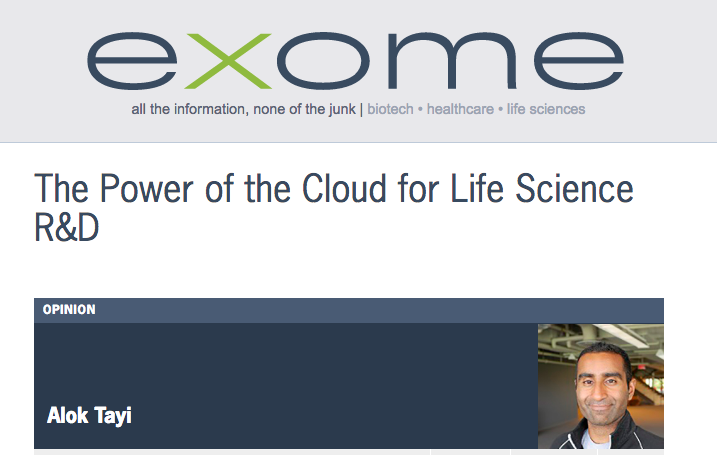Subscribe to our newsletter
Xconomy: “The Power of the Cloud for Life Science R&D”
 Alok Tayi is the CEO and co-founder of TetraScience (www.tetrascience.com). Prior to TetraScience, he was a post-doctoral fellow in George Whitesides Lab at Harvard University. Alok completed his B.S. and PhD in Materials Science at Cornell University and Nothwestern University, respectively. He also co-founded the open innovation platform, PreScouter. Alok has nearly 15 years of research experience and has published numerous high-impact papers in journals like Nature and Nature Chemistry.
Alok Tayi is the CEO and co-founder of TetraScience (www.tetrascience.com). Prior to TetraScience, he was a post-doctoral fellow in George Whitesides Lab at Harvard University. Alok completed his B.S. and PhD in Materials Science at Cornell University and Nothwestern University, respectively. He also co-founded the open innovation platform, PreScouter. Alok has nearly 15 years of research experience and has published numerous high-impact papers in journals like Nature and Nature Chemistry.
I recently had the pleasure of contributing an op-ed to Xconomy about something we’re quite passionate about here at TetraScience: “The Power of the Cloud for Life Science R&D”. You can read the article below, or see my original piece on xconomy.com
In the new world, it is not the big fish which eats the small fish, it’s the fast fish which eats the slow fish…” — Klaus Schwab, Founder/Executive Chairman, World Economic Forum
Over the past decade, the nature of innovation has changed—even as the pace has substantially increased. One of the reasons has been the ability to collect and analyze vast amounts of digital data, transforming industries from transportation and finance to defense and manufacturing. In R&D-intensive industries like biotech and pharma, data have always been critically important. Until recently, however, the full potential of that data has not always been realized, given the quantity, variety, and disparity of sources. But now that’s changing, because of the power of cloud-based software.
Unlike traditional software, cloud-based software is deployed on a central server and ‘rented’ by each organization or scientist as needed. That offers a number of advantages. Using the cloud, newly purchased software can be set up in a matter of minutes, instead of taking weeks. Software that uses cloud-based infrastructure also means customers can store and analyze a nearly infinite amount of data at low cost. Furthermore, improvements can be made instantaneously when new features are developed, ensuring that customers receive new functions and upgrades immediately.
While all industries gain from these general advantages of cloud software, the life sciences will also see unique benefits. In particular, cloud adoption in the life sciences offers seamless collaboration, improved operational efficiency, experimental automation, and advanced analytics.
Cloud-based collaboration
Science is all about data. Yet the methods we’ve used in the life sciences to produce, manage, collaborate around, and analyze data haven’t changed much in decades. Typically, we end up with breadcrumb-like trails of data in numerous different locations and formats—written in lab notebooks, files on USB drives, or notes in an ELN (electronic laboratory notebook). For projects that are distributed (such as between a client and a contract research organization), global (such as large pharma), or being transferred (e.g. discovery chemistry to scale up), this diaspora of data is a major bottleneck.
Cloud-based software solves this problem. All of the data are in the same place. Every bit of the data is easily accessible by all collaborators.
The benefits are substantial. Companies anywhere in the world can easily and securely access data no matter where they were generated. The companies also can maintain a single repository of record and enable different stakeholders to provide inputs on the same data set. Using the cloud, collaboration becomes a central pillar of the R&D landscape. Two fast-growing providers of cloud-based data management software that do this well are Benchling and Ovation.
Experimental workflows
Traditional R&D is labor intensive. Scientists do experiments at the lab bench, operating their instruments in person and collecting data on paper or a USB drive. The need to manually collect data and push buttons severely limits productivity and contributes to irreproducibility.
Cloud-based software can dramatically change the way scientists perform experiments by connecting individual scientific instruments directly to the cloud. That capability enables value-added functions like remote control, feedback loops, and the integration of instruments from multiple vendors without expensive, custom-built software. It also makes it much easier to automate experiments. Since all data and events are logged, experimental records provide complete visibility across the entire workflow and project.
Operational efficiency
R&D, like any business process, is dependent upon the production of high-quality data. In the case of the life sciences, scientific instrumentation is half of the data-producing pie. (People are the other half.) Yet the way we maintain and manage instrumentation is plagued with inefficiencies. Those inefficiencies include instrument downtime, limited availability, and untracked assets.
I have seen too often the crippling effects of instrument problems on discovery projects. A malfunctioning piece of equipment can delay projects by 1-2 months, depending upon servicing times. Just two weeks of instrument failure can lead to delays that cost up to $200K per time-sensitive project.
Cloud-based software and sharing of operational data can remedy this issue, by providing greater visibility across the enterprise and with external vendors. A good example of how cloud-based technology can improve operational efficiency is via remote diagnostics, such as the services from Agilent. Remote Advisor (RA) is one way many users of Agilent-manufactured equipment improve instrument up-time and track consumable use.
Advanced analytics
A critical part of any scientific experiment is the analysis. In the traditional R&D paradigm, the amounts of data are small enough that they can be managed easily by an individual and common PC-based software (e.g. Excel). However, in the modern era of research, a single scientist produces far more data than can be processed and visualized using these traditional methods.
Cloud computing provides a unique technical solution for dealing with this deluge of data. Large data sets can quickly be stored and analyzed on-demand. That’s been especially valuable in areas like genomics. DNA is both information dense and information rich. As a result, a genetic sequence produces huge amounts of data that cannot easily be managed on-premise. Furthermore, many of the insights into DNA arise from analyzing numerous sequences. One of the largest players in this space is Illumina. Their flagship cloud offering is BaseSpace. An expandable repository for data, BaseSpace also offers numerous applications (akin to an iPhone’s App Store) that can analyze data produced by Illumina machines.
A cloud-enabled future
Speed is the name of the game. In the modern life sciences environment, those who are the fastest to produce, analyze, and make decisions from data will be the winners. The challenge has been that historical computing approaches have limited the pace with which a scientist, a department, or a company can innovate.
Cloud-based software promises to accelerate time-to-completion for projects. It promotes collaboration, improves operational efficiency, enables the automation of experiments, and facilitates sophisticated analytics. Furthermore, a future in which experimentation is aided by cloud software inspires us to consider the promise of machine learning and artificial intelligence (AI) as well.
We have seen the disruptive power of these computing paradigms in other areas and predict that the impact will be substantial in life sciences as well. Imagine an AI program that dynamically improves the yield of small-molecule API synthesis, or a machine learning-based system which infers the composition of a sample by comparing chromatographic signatures to a database of historical samples, or an algorithm that predicts when an instrument is out of range or about to fail, before it actually does. This is the future for R&D that is enabled by cloud software.

